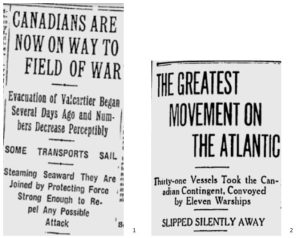 THIS DAY IN RMR HISTORY, 05 October 1914 – “By order of the Minister of Militia, the Department of Marine and Fisheries and the Department of the Naval Service had been requested to ensure “that every possible precaution may be taken to detect and prevent the laying of mines in the St. Lawrence, or elsewhere on the route to England”: neither had equipment for mine-sweeping, but both issued warnings that careful watch should be kept for mines or suspicious vessels in the river – they did not accept responsibility for the remainder of the route.
THIS DAY IN RMR HISTORY, 05 October 1914 – “By order of the Minister of Militia, the Department of Marine and Fisheries and the Department of the Naval Service had been requested to ensure “that every possible precaution may be taken to detect and prevent the laying of mines in the St. Lawrence, or elsewhere on the route to England”: neither had equipment for mine-sweeping, but both issued warnings that careful watch should be kept for mines or suspicious vessels in the river – they did not accept responsibility for the remainder of the route.
Before leaving Quebec strict injunctions had been issued in secret orders to captains of vessels from Rear-Admiral R.E. Wemyss, C.M.G., M.V.O., – the British Naval Officer appointed to command the trans-Atlantic escort – for the covering of lights, which were observed, and for the closing down of ships’ wireless, which were not always observed at first. Strict regulations forbidding the publication, without lawful authority, of any naval or military information, although passed by Privy Council ten days earlier (P.C. 2358 of 12.ix.1914) were not made public until three months later; as an immediate precautionary measure, however, the press had been warned, before the first transport arrived at Quebec, against giving the names of the ships or making mention of the embarkation of the force. This was complied with by almost all Canadian newspapers, but soon the information was broadcast to the world at large. On 28 September, in the very midst of the embarkation, the Governor-General was reported in the press to have stated at a public meeting in Ottawa: – “Recently I have had the pleasure several times to visit Valcartier, and also to be present at what is perhaps no longer a secret, the embarkation of the Canadian troops.”
On the same occasion the Prime Minister is reported to have said: – “Twice I have visited Valcartier Camp. Those of you who have not had that opportunity may be assured that the expeditionary force which has just embarked comprises as splendid a body of men as will be found among the armies of the Empire.”
These pronouncements were calculated to deceive the enemy and, to further the deception, Admiral Wemyss let the press understand that the transports were sailing independently. The War Office was scrupulous to encipher all cables, and had pressed for details of personnel, horses and material in each transport; the list was so extensive that the department warned the War Office that it would be sent in clear, and so dispatched it. The warning cable drew remonstrances from the War Office, and the reply given was: “Your telegram received too late,” and on the same day: “Unlikely to do harm … Names of transport and strength of Contingent had already been published.” As it happened no harm was done, and although even newspapers with ample information undoubtedly reached Germany before the convoy made port, no effectual interceptive action was taken by the German Admiralty; it is now known that Admiral von Tirpitz believed 20,000 Canadians to be in Le Havre on 8th October.” [3]
“On October 5th, a supposed German collier was encountered by the convoy and two days later the H.M.S. Glory stopped a Scandinavian tramp with several shots across the bow. These vessels were suspected of supporting the German cruiser Karlsruhe, which was at large in the Atlantic, but so far as the troops could gather, no proof was forthcoming.” [4]
[1] “Canadians Are Now On Way To Field Of War,” Special to The Gazette from Staff Correspondent, The Gazette, Montreal, Quebec, Friday, September 25, pg. 1, col. 3
[2] “The Greatest Movement On The Atlantic,” Special Staff Correspondent, The Montreal Daily Mail, Montreal, Friday, October, 2, 1914, pg. 3, col. 1.
[3] Col. A.F. Duguid, “Official History of the Canadian Forces in The Great War 1914-1919, Vol. 1, Part 1, King’s Printer, Ottawa, 1938, pp. 94-96.
[4] R.C. Featherstonhaugh, The Royal Montreal Regiment 14th Battalion C.E.F. 1914-1925, Montreal, The Gazette, Printing Co., Ltd., 1927, pg. 14.

